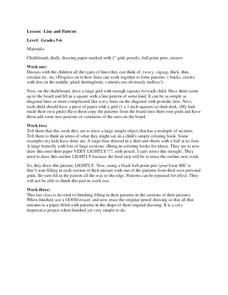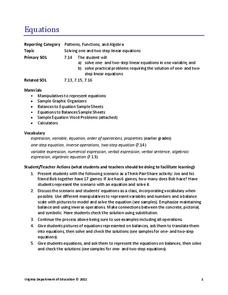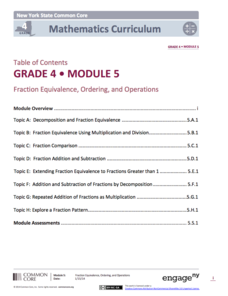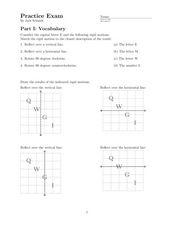EngageNY
The Binomial Theorem
Investigate patterns in the binomial theorem. Pupils begin by reviewing the coefficients from Pascal's triangle. They look at the individual terms, the sums of the coefficients on a row, and the alternating sum of each row. Individuals...
Curated OER
Mining in a Nutshell
Your class will love this geology-inspired set of activities that demonstrate the processes through which we are able to use mineral resources. They describe the major steps that a company must follow from initial discovery of a mineral...
Curated OER
Pennies of My Life Part II
Youngsters write and construct their own autobiographies based on The Hundred Penny Box by Sharon Bell Mathis. They engage in pre-writing steps, narrative writing, and peer editing. This is the second part of a two-part project lesson.
Curated OER
Design Patterns in Everyday Life
Students find symbols and patterns in everyday life. In this patterns lesson, students break into groups and look for specific patterns and symbols. Students record their findings. Students create a graphic organizer with the information.
Curated OER
Line and Pattern
Students investigate lines and patterns. In this line and pattern instructional activity, students discuss types of lines and work on grids. They draw a picture very lightly before filling it in with the pattern they made in the grid.
Virginia Department of Education
Equations
Science equipment can be handy for math class, too. Scholars learn to solve one- and two-step linear equations by using the concept of a balance. They solve real-world problems in a variety of contexts by writing and solving linear...
PBS
The Yo-Yo Problem
What do yo-yos and pennies have to do with linear equations? Learn about writing and solving linear equations while considering the Yo-Yo Problem and Penny Pattern Exploration from the High School Math Project. Learners utilize algebra...
Curated OER
Decomposing Numbers Step-By-Step
Here are two addition-related exercises. However, bear in mind, the explanations are featured below each of them. Use this as an all-class warm up, revealing the explanations if and when you see fit. First, examine the four sets of...
Curated OER
A STEP IN SPECIATION
Students place different subspecies of a CA salamander are placed on grid map of CA according to where samples were collected. Then discuss patterns of their distribution, their likely evolutionary relationships, and probable sequence of...
Curated OER
Tukutuku Patterns
Young scholars complete a series of lessons involving Tukutuku patterns, their rotations and area formulae. They determine the algebraic formulae for sequences. They use images as they work through the lessons to find the number of...
Curated OER
Gummy vs. Gum
Students explore numbers patterns and write equations to describe the pattern. They apply the equations to further the patterns.
Curated OER
The Tango
Fourth graders explore the music of Buenos Aires as they hear and then dance the Tango. They practice basic Tango rhythm, learn to sing the song, "Any Turkey can Tango," then practice a few Tango-riffic dance steps with a partner. What a...
Curated OER
Clothe Batik and Color Blending
Fabric dyeing and textile art has been around for hundreds of years. Budding fabric artists explore the Batik dyeing technique and color blending as they create unique and personal designs. The full step-by-step procedure and materials...
Curated OER
The Wonderful World of Escher
Bridging art and math can be as easy as making tessellations. The art, context, and life of M.C. Escher is explained to the class, as is the concept of tessellations. After a bit of art history, pupils get out the ruler, tape, and...
Curated OER
Red Circle, Red Circle, What Do You See?
Young learners explore shapes and colors. They listen to Brown Bear, Brown Bear What Do You See? by Bill Martin Jr. and use the same language pattern to create a color and shape book of their own. After that, with the leftover magazine...
EngageNY
Fraction Equivalence, Ordering, and Operations
Need a unit to teach fractions to fourth graders? Look no further than this well-developed and thorough set of lessons that takes teachers through all steps of planning, implementing, and assessing their lessons. Divided into eight...
Chicago Botanic Garden
Historical Climate Cycles
What better way to make predictions about future weather and climate patterns than with actual climate data from the past? Young climatologists analyze data from 400,000 to 10,000 years ago to determine if climate has changed over time....
Alabama Learning Exchange
Find a Pattern Using Children's Literature
Sixth graders listen to Demi's, On Grain of Rice: A Mathematical Folktale. They use the problem solving strategy of finding a pattern to determine the number of rice Rani will receive after 30 days. They create a spreadsheet which...
Curated OER
Using Polya's 4 Steps to Problem Solving
Ninth graders solve problems using Polya's 4 steps to problem solving.
Curated OER
Frieze Patterns
In this frieze pattern worksheet, students draw frieze patterns that can be constructed from a given motif. They perform translations, glide reflections, horizontal and vertical reflections and 180 degree rotations. This one-page...
Curated OER
In and Out Function Problems
Third graders solve In and Out function problems. They analyze a chart and discuss the steps to solving the functions, and discuss the patterns and complete the charts. Students then create a book of repeating patterns using magazines,...
Curated OER
Geometry Practice Exam
In this reflections and rotations worksheet, learners reflect and rotate lines in graphs and draw lines of symmetry through patterns. Students complete 24 problems.
Curated OER
What's the Best Deal?
Young scholars explore number sense by solving consumer math problems. In this pattern identification lesson, students analyze a list of numerical and geometric patterns while predicting the future outcome. Young scholars utilize...
Curated OER
Solving Equations Using Two Operations
Need more detail in showing your class how to solve two-step equations and proportions? This lesson plan outlines the steps young mathematicians need to solve simple equations and check their results.

























